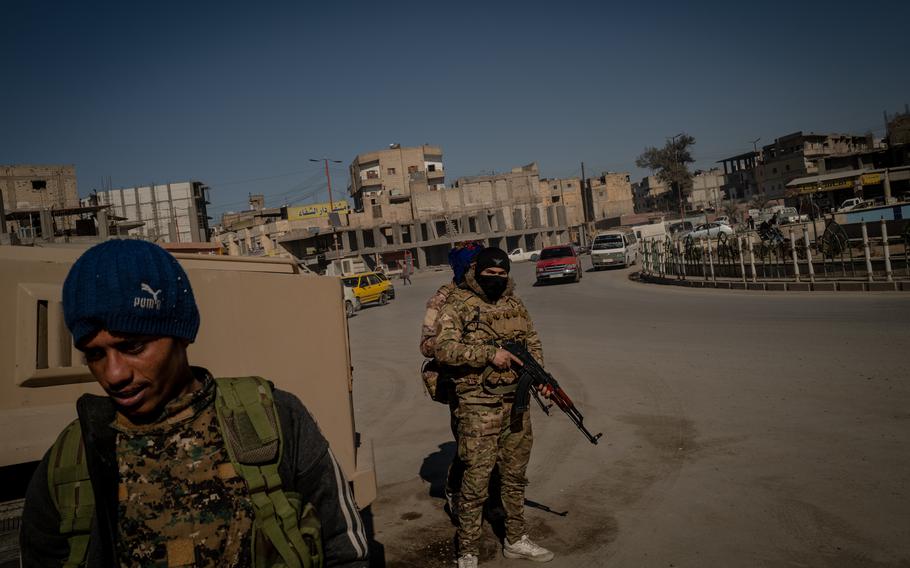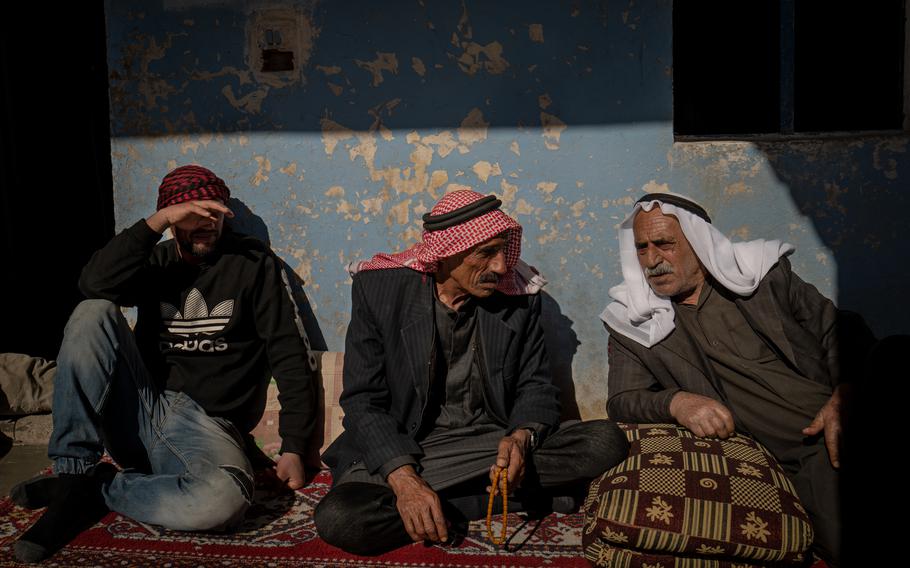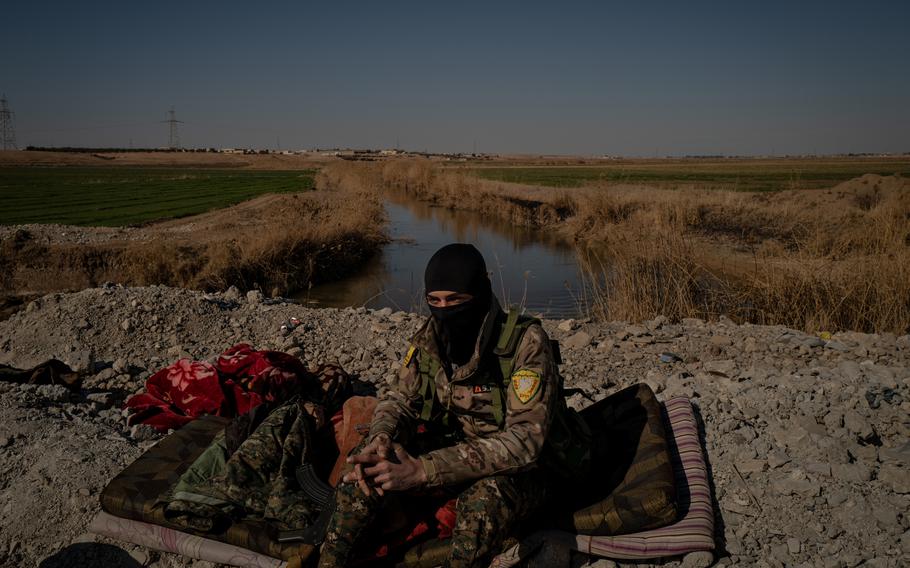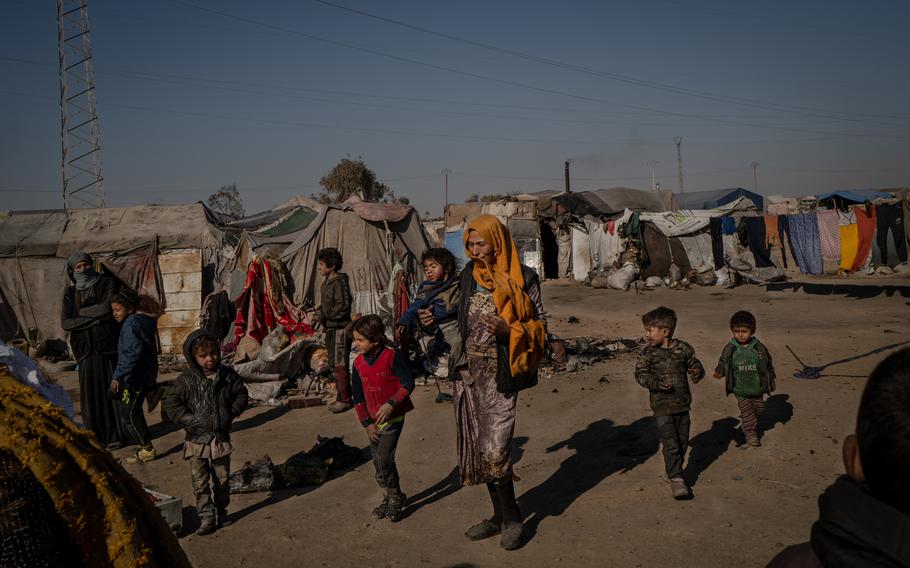
Fighters with the U.S.-backed Syrian Democratic Forces are on the lookout in Naim Square, in Raqqa, Syria, on Feb. 5, 2022. (Nicole Tung/The Washington Post)
SHADADI, Syria — In the countryside around this market town, people prefer not to travel after dark. Rumors abound that militants stalk the roads then. Three years after the defeat of its self-declared caliphate, the Islamic State group is reconstituting itself in the Syrian shadows, and few villagers want to test their luck.
“It’s not safe out there,” said Khalifa Salim al-Jeddal, 64, his grave expression framed with deep wrinkles from years in the sun. “There are places I know I can’t just get in my car and drive to. There are sleeper cells.”
A farmer from the nearby village of Jallo, Jeddal knows the risks more than many. The militants tortured him when they ruled his village, he said. Now they’re growing in confidence again, sometimes wearing military fatigues that make them indistinguishable at a distance from the area’s U.S.-backed security forces.
This is the Islamic State in 2022. No longer holding territory, as the group did until 2019, but lying low in small groups, operating with increasing sophistication and exploiting the breathing spaced afforded by Syria’s fractured politics to rebuild. They are also taking advantage of the local Kurdish-led administration’s struggles to fully govern the broad swath of northeastern Syria it has come to control since the fall of the caliphate, recruiting informants from impoverished communities and intimidating individuals who work with local government.

Khalifa Salim al-Jeddal, center, a farmer, is seen at home in the village of Jallo in northeastern Syria on Feb. 6, 2022. (Nicole Tung/The Washington Post)
The dangers were dramatically underlined last month when hundreds of Islamic State fighters assaulted a prison holding suspected militants in the northeastern city of Hasakah. American and British special forces were forced to join the 10-day battle to recapture it. More than 500 people died, about three quarters of them ISIS members, according to the Syrian Democratic Forces (SDF).
“These cells came from different places,” said Mazloum Kobane, who leads the U.S.-backed SDF in northeastern Syria. “They spread out people in neighborhoods around the prison to create chaos as soon as the attack began.”
As the violence unfolded in Hasakah, militants were carrying out attacks elsewhere in northeastern Syria.
At a rural checkpoint in Deir al-Zour province, Yasser was partway through another freezing night shift as a member of the region’s internal Kurdish-led security forces when he saw six men on motorcycles coursing down the otherwise empty road toward him. Two of them had suicide vests strapped to their chests, recounted Yasser, who described the event on the condition that his last name not be used because of safety concerns. He would later learn that similar attacks had unfolded at two other checkpoints.
As some members of Yasser’s unit fled the ensuing gun battle, no one in the village offered them shelter.
“People were whispering through the doors, telling us: ‘Please go. We can’t open the door for you,’” Yasser recalled. “They said, ‘If ISIS finds out, they will kill us.’”

Amir, a fighter with a U.S.-backed Syrian force, is shown at a checkpoint in Raqqa governorate on Feb. 5. (Nicole Tung/The Washington Post)
The militants have taken advantage of Syria’s political divisions to rebuild their fighting capabilities. Under pressure from the SDF and the U.S.-led military coalition, some Islamic State cells had retreated in 2019 from northeastern Syria to territory controlled by Syrian President Bashar Assad’s forces, where operations against the group were less sustained. Then, after the militants came under fire there, they slipped back into the Kurdish-led region.
“They had moved people to a more viable front for survival, and that was central Syria. Now the most viable front again is the northeast,” said Gregory Waters, a nonresident scholar at the Middle East Institute.
Mazloum and other SDF officials noted that some of the attackers in Hasakah appeared to have spent time in ISIS training camps in areas controlled by Assad’s forces, and the militants who returned to northeastern Syria have demonstrated a greater ability to carry out complex attacks.
In the past, Kurdish officials had said there was little coordination among the small sleeper cells operating in the northeast. But officials suggested after the Hasakah assault that it had involved three separate cells operating with high-level coordination and that there had been a centralized decision to carry out the attack.
Waters said that the Islamic State in Syria has again become capable of carrying out sophisticated operations. The group has developed “a slimmer, centralized core of veteran fighters who are linked into broader regional networks planning less-frequent but larger, more-complex attacks, while the more peripheral, decentralized cells carry out the day-to-day low-level insurgency,” he said.
Intelligence gathered in U.S. surveillance of Islamic State leader Abu Ibrahim al-Hashimi al-Qurayshi in the months before he was killed in an American raid on Feb. 3 indeed indicated that he had stayed in touch with a network of underground cells in parts of Syria and Iraq.
Qurayshi’s death is likely to “disorient” the Islamic State group and reduce its effectiveness, at least for the time being, according to Hassan Hassan, the editor in chief of New Lines magazine. “For now, the group is in a weakened state, but that is not the same as not being dangerous,” Hassan said. He said that Qurayshi did not have wide appeal and that the selection of a new leader could enhance the “group’s odds at energizing its base and appealing to new people.”
As some Islamic State cells have returned to northeastern Syria, the SDF has found itself with less visibility into their operations than before. For one thing, it has little insight into militants’ activities in adjacent areas held by the Syrian government west of the Euphrates River or Turkish-backed forces in the north, and sometimes in neighboring Iraq.
“Everyone’s working in silo,” said Dareen Khalifa, a senior analyst at the International Crisis Group.

A scene inside Sahel al-Banat camp for internally displaced people in Raqqa governorate on Feb. 5. (Nicole Tung/The Washington Post)
Islamic State militants have also capitalized on the Kurdish-led administration’s struggles to govern in majority-Arab areas that have fallen under its rule. Arab residents have protested over poor public services and what they describe as arbitrary detentions during anti-ISIS raids.
The militants exploit this discontent, paying some residents small sums to be informants, for instance supplying information about the activity of community leaders or the movement of security forces. In some cases, insurgents have intimidated and even killed people who cooperate with local government. As a result, Khalifa said, local authorities are finding it harder to generate intelligence about militant activities. “Some people don’t think [local] forces are capable of protecting them,” she said.
SDF officials point in particular to the region’s sprawling, ramshackle camps housing thousands of people displaced from their homes by fighting and poverty, where the militants might try to make inroads. Several dozen camp residents have been arrested in recent months, the SDF said, accused of offering support to the Islamic State in return for cash.
“ISIS is taking advantage of the poverty in this region,” said Farhad Shami, a spokesman for the SDF. “They have tried to use displaced people as a weapon,” he said.
The conditions in many of the camps are dire. Residents are at times short of bread and other food, wear threadbare clothes and burn trash for warmth against the winter cold.
Camps around the city of Raqqa, once the capital of the Islamic State’s self-declared caliphate, have swelled in recent years as climate change and drought have accelerated the immiseration of tens of thousands of pastoralists who say they have had no choice but to migrate toward cities in search of work.
But once they arrive, they find few opportunities. Many live in grinding poverty. For local notables and tribal elders who have acted as brokers between their communities and the SDF, the arrival of so many strangers has also limited visibility into what happens among the newcomers.
The Washington Post’s Mustafa al-Ali contributed to this report.